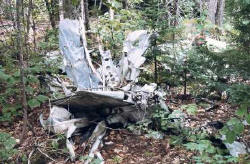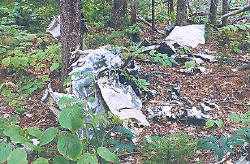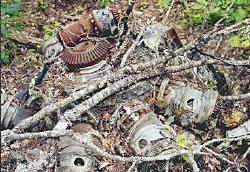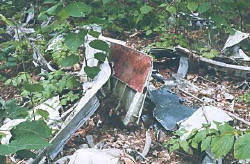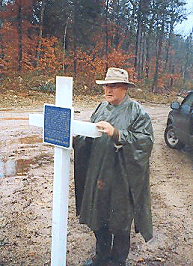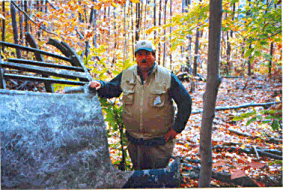|
Millinocket, Maine and the Katahdin Region On Friday, June 30, 1950, Royal Canadian Navy Lieutenant Mervin C. “Butch” Hare of the 803 Naval Fighter Squadron took off from Montreal Quebec and flew off into Maine aviation history. Hours later, when the FB. 11 Hawker Sea Fury failed to arrive at its home base of Shearwater Naval Air Station in Dartmouth, Nova Scotia, a massive international air search was launched. Lt. Hare was assigned as a test pilot and was ferrying the aircraft from Toronto to Dartmouth after it had undergone an overhaul. The plane’s flight plan was to take it across northern Maine and eastern New Brunswick. This left a wide flight path of uninhabited forest on both sides of the border where the plane could have made a forced landing or crashed.
The U.S. search focused on a 75 mile long
area from Maine’s Mount Katahdin east to the New Brunswick border. The
area had seen heavy overcast and rainstorms that day. Several people at
remote camps and a fire tower had seen a single engine aircraft, fitting
the description of the Sea Fury, flying at low altitude during the
afternoon. The reported directions of travel indicated that the pilot may
have been lost or trying to find a landing area due to an aircraft
problem. The search group averaged over 30 flights per day without locating any sign of the missing warplane. A ground team hiked to a possible crash site, but it turned out to be a stand of trees blown over by the wind. After five days of searching, with no physical clues, the search was called off by the Air Force. Additional witness statements seemed to indicate that the aircraft had crossed Maine and was most likely down somewhere in New Brunswick. Seven days later, the Canadian search was also called off. By December 1953, a local newspaper article declared “Somewhere out in the thousands of square miles of forest that are Maine, are the bodies of four men and the wreckages of three aircraft.” Two light civilian planes had been added to the mysteries of the Maine woods over the intervening three years. Ironically, two Millinocket flyers who had searched for Lt. Hare and TF 997 added to the toll in the summer of 1956, when they disappeared flying in a float plane in the same general area. Their fate would remain a mystery until a Game Warden spotted the crash site from the air thirteen years later. Unless an aircraft crash cuts a path through the trees, crashes on a leaf barren hardwood ridge during the cold months, or seriously burns the surrounding area, it is nearly impossible to spot from the air in the Maine forest. Numerous remote lakes in northern Maine are additional areas in which an aircraft can disappear for years, even decades. An F-102 “Delta Dagger” crashed into one such lake in 1959 and remained missing until part of it turned up sticking up through the ice during a low water year, 20 years later! The location of Sea Fury TF 997 and the fate of Lieutenant Hare remained unknown and the topic of aviator speculation, as well as woods camp lore for nearly eighteen years. Then in February 1968, two foresters for a local lumber company were cruising timber about a mile from a remote logging road. As they crossed a small finger ridge above a brook, they found some unusual damage to several trees. Closer inspection revealed pieces of aluminum stuck in some trees and several large pieces of twisted wreckage sticking up through three feet of snow.
The plane had struck a tree on top of the ridge with its port wing root and struck the ground within about 150 feet. The force of the impact dug a 15 foot diameter crater and the aircraft broke up and scattered, within a 50 yard radius. There had been several small fires. Lt. Hare’s parachute harness pieces were later found near the crater, ending an initial speculation that he had bailed out and perished somewhere else in the Maine woods.
I first learned of this site while searching for information about an F-86 crash twenty miles away. I had collected numerous verbal reports of a military aircraft wreck on top of a small mountain near the final resting place of TF 997. It was described by various local residents as a B-17, and sometimes as a P-47. Each one of these leads was a dead end. The mountain is barren of any wreckage and no record of such a crash showed up in my research. As years pass, multiple accidents tend to blend together in the minds of local residents. There is, in fact a C-54 wreck on top of a separate mountain within a dozen air miles of this crash site, which was probably the basis for these leads.
One person whose name came up as a possible
witness to my F-86 crash told me that he knew nothing about it, but was at
the scene of the Sea Fury crash a few months after it was located. He
gave me a detailed description of the ridge on which the plane had crashed
and an approximate location from one of the newer logging roads that
traverse the area. Within a few weeks, I had gathered information about
the incident from the Canadian Archives and newspaper clippings at a local
library. Eventually, I obtained a copy of the Royal Canadian Navy inquiry
into the incident.
On the first visit to the area with two friends, we searched the wrong ridge thoroughly. Two subsequent solo searches were cut short by summer thunder showers. Two days of searching the right ridge came up empty also. Finally, while searching the remaining areas of the ridge, I noted a wing spar standing against a tree. A few steps farther and I was standing in the wreckage field. This has turned out to be one of the more interesting Cold War era crash sites that I have visited. The tree that the plane struck still stands nearby. New branches have grown up around its severed top. In the bottom of the crater are the propeller hub with three bent blades attached. Also in the crater are a main landing gear strut, oxygen bottles, supercharger parts and one cylinder from the radial engine, which lays 50 feet from the crater. Between the engine and crater is the barely recognizable tail section. Nearby is the armor plate from the rear of the cockpit. Pieces of the wings and horizontal stabilizers are scattered along with small fuselage pieces for 50 yards through the woods. It took several hours of walking around the site to make sense of the wreckage pattern.
On October 23, 1999, I lead a day trip to
this site arranged by the Maine Aviation Historical Society, of which I
am a member. The group consisted of 9 MAHS members and guests.
Participation in the event was less than expected due to a heavy cold fall
rainstorm that day. We certainly found out who the serious wreck chasers
are! After a briefing on the story of the disappearance and discovery of
TF 997 and a short discussion of “crash site etiquette” everyone walked
over and explored the site. A cross with a memorial plaque to Lt. Hare
was erected and dedicated at the site, with landowner permission.
The landowner has agreed to give this site “special area” status that will hopefully help preserve it for future generations to see. As in other areas of the U.S., crash sites in Maine are subject to damage from wood harvesting operations, scrap metal hunters, and souvenir pickers. Working with landowners to understand the historical significance of such sites is the first step toward preventing site obliteration. In just the small area of Maine known as the “Katahdin Area” 15 World War II and 11 Cold War era American and Canadian military aircrew have lost their lives over the past 60 years. Four non-fatal accidents have also occurred. These facts and figures take on a whole new personal meaning once you’ve actually visited a crash site. The work of researching, locating, and preserving these often forgotten sites will give us and future generations a unique insight into the true cost of our freedom. Published in Lost Birds Magazine in 2000 About the author...........
Pete Noddin is Vice President of the Maine Aviation Historical Society
which is dedicated to preserving Maine's aviation heritage. Pete and a
group of dedicated volunteers within MAHS focus on aviation archeology, a
"niche" within aviation history that strives to document aviation mishaps,
attempt to solve "mysteries", as well as preserve and document crash
sites.
Click here to view a collage of photos taken by this webmaster in 1979.
|


